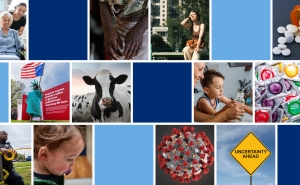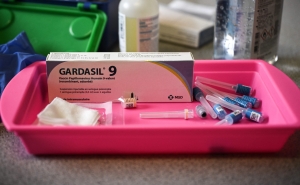
Q&A WITH DANIEL SALMON
The U.S. on April 13 paused use of the Johnson & Johnson COVID-19 vaccine because, of the nearly 7 million people who received the vaccine, six women under 50 developed a rare form of blood clots called cerebral venous sinus thrombosis, or CVST.
This follows a similar move in Europe where several countries suspended use of the AstraZeneca COVID-19 vaccine because, of 17 million people in the EU and the UK who received the vaccine, 37 had CVST.
Daniel Salmon, PhD ’03, MPH, a professor in International Health and director of the Institute for Vaccine Safety, shares his take on what to make of such pauses.
How should we view these situations generally?
Bad things happen to people every day from a health perspective. People have heart attacks, people have strokes, people get infectious diseases, and chronic diseases, and cancer. People get hit by cars and shot by guns. And if you vaccinate people, these things will happen after people got the vaccine, by chance alone.
How frequently these things happen depends on the population. So, if we vaccinate a lot of people in a short amount of time, we have to anticipate that bad things will happen to them, hopefully at the same rate that would have happened anyway (except for the disease you’re vaccinating against, in this case COVID, which hopefully that happens less). The question is, is it because of the vaccine, and specifically [is it happening] more frequently after getting the vaccine? If, after you look at the data, you find that it still persists, usually you want to do a chart review and look for standardized case definitions and really do a more formal study.
The Johnson & Johnson and AstraZeneca vaccines were paused for the same reason. What are your thoughts on how these two situations have played out so far?
The situation with the J & J vaccine really requires more data. Ultimately, vaccine decisions are about weighing risks and benefits of the vaccine. Fortunately in the U.S. we have two other highly effective vaccines to use that have not raised similar safety concerns.
What do you make of the pauses in administering these vaccines?
Stopping the vaccine comes at a risk as well because those are people that aren’t getting vaccinated in the midst of a pandemic. But with that said, they want to be careful with safety and that’s a good thing. The availability of other vaccines makes this decision easier.
If this is in fact a pattern, you need to look at the risk of these blood clots among women in this age group and how much risk it is, and then compare it to the benefit of the vaccine. Because at the end of the day, it’s all about risk versus benefits. For example, flu vaccine causes Guillain-Barre syndrome in one to three per million people vaccinated. Guillain-Barre is a pretty serious neurological condition. However, it’s a one to three per million chance, and the benefits of the flu vaccine are far, far greater than that.
What does this say about the systems in place to find, report, and investigate any adverse events?
The systems are working because they identified something that looked unusual and they’re assessing it rapidly and making decisions from there. The decision to suspend it is a difficult judgment call. You don’t want to suspend something absent that reason, because it just confuses people, and potentially you’re not vaccinating people when you could.
Is this likely to hurt vaccine confidence and increase vaccine hesitancy?
You have to think about short term versus long term. In the short term this might cause some issues that may result in some people not getting vaccinated who would otherwise get vaccinated. But we’re not in it for the short term. We’re not going to eradicate COVID any time soon, if ever. We’re really fortunate to have multiple vaccines that look extremely good so quickly. It’s really a tremendous success.
This is about long-term trust and confidence in the system. And you can ask yourself, do you want a system that looks really hard for unusual, unexpected things; and, when it sees something weird, has really good science and scientists to investigate it to determine whether it just appears a little bit weird, or if it actually is weird; and if it is a problem, among whom and how frequently, so that when you and your doctor decide whether or not to get a vaccine, you have the best available information? Or would you rather they just not look and pretend it’s not there, and tell everybody it’s OK, and provide reassurance absent science, because if they did the science and told you about it, you might question it for a moment? I think the answer is clearly that people want the former.
Yes, there may be a short-term hit. And that has to be considered and words have to be chosen carefully. But we need a robust process. It needs to be objective, it needs to be driven by science, and it needs to be reasonably transparent. It doesn’t mean that every conversation should be put on the web, but the public needs to know that there are independent, credible, very competent people looking at issues carefully, and they’re taking a cautious approach. I know that’s what I want, and I think that’s what most people want.





